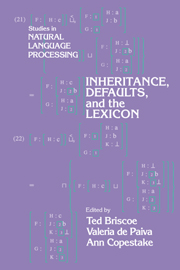Book contents
- Frontmatter
- Contents
- Contributors
- 1 Introduction
- 2 Skeptical and Credulous Default Unification with Applications to Templates and Inheritance
- 3 Prioritised Multiple Inheritance in DATR
- 4 Some Reflections on the Conversion of the TIC Lexicon into DATR
- 5 Norms or Inference Tickets? A Frontal Collision between Intuitions
- 6 Issues in the Design of a Language for Representing Linguistic Information Based on Inheritance and Feature Structures
- 7 Feature-Based Inheritance Networks for Computational Lexicons
- 8 A Practical Approach to Multiple Default Inheritance for Unification-Based Lexicons
- 9 The ACQUILEX LKB: An Introduction
- 10 Types and Constraints in the LKB
- 11 LKB Encoding of Lexical Knowledge
- 12 Defaults in Lexical Representation
- 13 Untangling Definition Structure into Knowledge Representation
- Appendix A A Bibliography of ACQUILEX Papers Connected with the LKB
- Appendix B The LKB Description Language Syntax
- Appendix C Software Availability
- References
- Author index
- Subject Index
10 - Types and Constraints in the LKB
Published online by Cambridge University Press: 01 April 2010
- Frontmatter
- Contents
- Contributors
- 1 Introduction
- 2 Skeptical and Credulous Default Unification with Applications to Templates and Inheritance
- 3 Prioritised Multiple Inheritance in DATR
- 4 Some Reflections on the Conversion of the TIC Lexicon into DATR
- 5 Norms or Inference Tickets? A Frontal Collision between Intuitions
- 6 Issues in the Design of a Language for Representing Linguistic Information Based on Inheritance and Feature Structures
- 7 Feature-Based Inheritance Networks for Computational Lexicons
- 8 A Practical Approach to Multiple Default Inheritance for Unification-Based Lexicons
- 9 The ACQUILEX LKB: An Introduction
- 10 Types and Constraints in the LKB
- 11 LKB Encoding of Lexical Knowledge
- 12 Defaults in Lexical Representation
- 13 Untangling Definition Structure into Knowledge Representation
- Appendix A A Bibliography of ACQUILEX Papers Connected with the LKB
- Appendix B The LKB Description Language Syntax
- Appendix C Software Availability
- References
- Author index
- Subject Index
Summary
Introduction
This chapter describes – from a mathematical perspective – the system of typed feature structures used in the ACQUILEX Lexical Knowledge Base (LKB). We concentrate on describing the type system the LKB takes as input, making explicit the necessary conditions on the type hierarchy and explaining how – mathematically – our system of constraints works. It is assumed that the reader is familiar with basic unification-based formalisms like PATR-II, as explained in Shieber (1986). It must also be said from the start that our approach draws heavily on the work on typed feature structures by Carpenter (1990, 1992).
The LKB works basically through unification on (typed) feature structures. Since most of the time we deal with typed feature structures (defined in section 10.2) we will normally drop the qualifier and talk about feature structures. When necessary, to make a distinction, we refer to structures in PATR-II and similar systems as untyped feature structures. Feature structures are defined over a (fixed) finite set of features FEAT and over a (fixed) type hierarchy 〈TYPE, ⊑〉. Given FEAT and 〈TYPE, ⊑〉 we can define T the collection of all feature structures over FEAT and 〈TYPE, ⊑〉. But we are interested in feature structures which are well-formed with respect to a set of constraints. To describe constraints and well-formedness of feature structures we specify a function C: TYPE → F, which corresponds to an association of a constraint feature structure C(ti) to each type ti in the type hierarchy TYPE.
- Type
- Chapter
- Information
- Inheritance, Defaults and the Lexicon , pp. 164 - 189Publisher: Cambridge University PressPrint publication year: 1994
- 1
- Cited by



